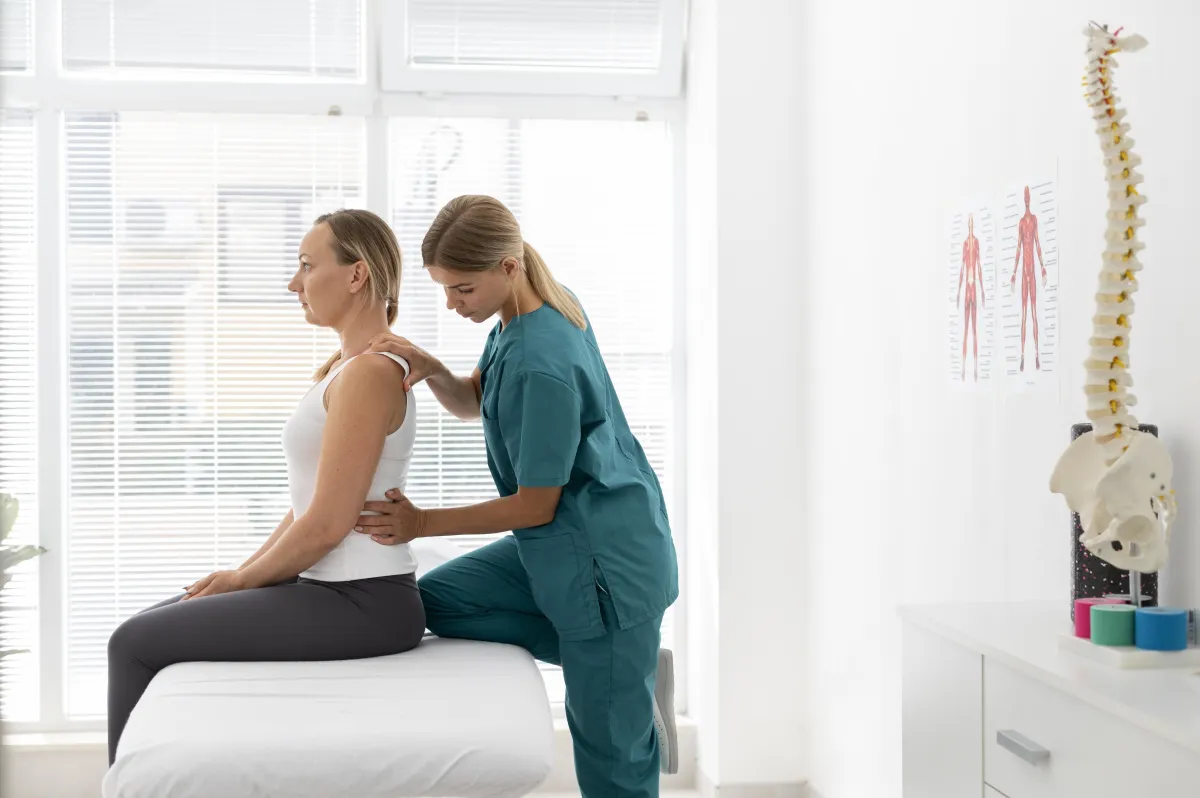Scoliosis Physiotherapy in NYC
Manhattan Physical Therapy

Introduction
In recent years, scoliosis management has shifted from a passive “wait and see” approach to a more proactive and evidence-based model. Many parents have expressed concern about the observation-only method used for mild curves between 10° and 25°. To address this, the 2011 International Society on Scoliosis Orthopedic and Rehabilitation Treatment (SOSORT) endorsed three key interventions for idiopathic scoliosis: observation, Physiotherapy Scoliosis-Specific Exercises (PSSE), and bracing — all emphasizing 3D self-correction, training in daily activities (ADL), and postural stabilization.
PSSE follows a patient-centered approach, combining scoliosis-specific education, targeted exercises, observation, psychological support, bracing, and surgery when needed. It complements, rather than replaces, other treatments, guided by diagnosis, clinical evidence, and patient preference. According to SOSORT and the Scoliosis Research Society (SRS), PSSE works best when delivered by a multidisciplinary team that includes physical therapists, orthopedic specialists, orthotists, and mental health professionals.
What Is Scoliosis?
Scoliosis is a spinal condition that causes an abnormal side-to-side curvature, often resembling an S or C shape. It affects an estimated 6–9 million people in the United States, and while anyone can develop scoliosis, it’s most commonly diagnosed in children over 11 years old as their bones continue to grow.
In many cases, scoliosis develops gradually and may not cause noticeable symptoms early on. Over time, however, the spinal curve can become more visible or lead to discomfort, uneven posture, or pain if left untreated. Early diagnosis and physiotherapy can help manage the condition effectively and prevent the need for surgical intervention.
What Are the Common Symptoms of Scoliosis?
Scoliosis can present differently depending on the severity of the spinal curve. In children and teens, early signs often appear as subtle asymmetries in posture. Typical symptoms may include:
Uneven shoulders or shoulder blades
One hip appearing higher than the other
A more prominent shoulder blade on one side
Uneven rib cage when bending forward
In severe cases, persistent back pain or fatigue after standing for long periods
What Causes Scoliosis?
There are three main types of scoliosis, each with distinct underlying causes:
Idiopathic Scoliosis:
Idiopathic Scoliosis:
The most common type, accounting for about 80% of all scoliosis cases. The exact cause is unknown, but risk factors include age, genetics, and sex — with adolescent girls being more commonly affected.Congenital Scoliosis:
Present at birth, this form results from spinal malformations that occur during fetal development. It may be detected early in life through routine pediatric examinations or imaging.Neuromuscular Scoliosis:
Caused by muscle weakness or neurological conditions such as cerebral palsy or multiple sclerosis (MS). Muscle tightness or spasms in these disorders can gradually pull the spine out of alignment.
Source: Medical News Today
Can Stretches and Exercises Help Scoliosis?
Yes — in mild to moderate cases, scoliosis-specific exercises and stretches can help prevent curve progression, relieve discomfort, and promote better posture without surgery. However, not every exercise is suitable for every patient. That’s why it’s essential to work with a qualified physical therapist who can recommend movements tailored to the type and severity of your scoliosis.
At our clinic, we incorporate Physiotherapy Scoliosis-Specific Exercises (PSSE) and core stabilization techniques to strengthen supporting muscles, enhance flexibility, and promote spinal balance. The following are some commonly recommended exercises for scoliosis management:
Pelvic Tilts
Arm and Leg Raises
Cat-Cow Stretch
Bird-Dog Exercise
Latissimus Dorsi Stretch
Abdominal Press
Source: Medical News Today
How Does Physiotherapy Help Manage Scoliosis?
Physiotherapy plays a vital role in the non-surgical management of scoliosis. Through targeted movement, posture correction, and strengthening exercises, physiotherapy helps improve spinal alignment and overall body balance. At Manhattan Physical Therapy, we focus on Physiotherapy Scoliosis-Specific Exercises (PSSE) — an evidence-based approach endorsed by international organizations like SOSORT and the Scoliosis Research Society (SRS).
Our scoliosis physiotherapy programs are designed to:
Reduce spinal curvature progression during growth stages
Improve postural awareness and daily movement patterns
Relieve muscle tightness and imbalance caused by uneven spinal loading
Enhance respiratory function, especially in thoracic scoliosis
Build strength and flexibility to support long-term spinal stability
What to Expect During Scoliosis Physiotherapy Sessions
At Manhattan Physical Therapy, your scoliosis care begins with a comprehensive evaluation that includes postural analysis, range of motion testing, and functional movement assessments. Based on the findings, our physical therapists develop a tailored exercise plan focused on 3D self-correction — teaching patients how to actively realign their spine through movement and posture control.
A typical scoliosis physiotherapy session may include:
Targeted stretching and strengthening exercises to balance muscle activity
Breathing techniques to improve lung expansion and chest mobility
Core stabilization training to strengthen abdominal and back muscles
Neuromuscular re-education to improve body awareness and alignment
Education on daily posture habits and safe movement strategies
Call (212)-213-3480 today or schedule an appointment online to start your scoliosis physiotherapy in NYC and take the first step toward a stronger, more balanced spine.
What others are saying
Alexander Liu
"Everyone on the team at Manhattan Physical Therapy is super nice and caring. They were able to pretty quickly diagnose my knee and hip problems and immediately put me to work to reduce the pain.."
Henry Myerberg
"You're not just a patient when you come to the Manhattan Physical Therapy. You feel like family there. In particular, Erica with her colleagues John, Lidia and Joe not only fix and improve you physically, they make you feel welcomed and cared for.."
Hakyung Kim
"Everyone is so kind and helpful! my knee and hip pain have improved massively since starting Manhattan PT, highly recommend to anyone. special thanks to Bianca, Lidia, Joe, and John!"
Manhattan Physical Therapy
✆ Phone (appointments):
(212) 213-3480
Address: 385 5th Ave, Suite 503, New York, NY 10016

